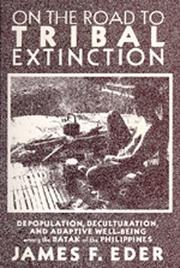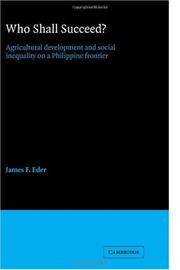| Listing 1 - 10 of 10 |
Sort by
|
Book
Year: 1970 Publisher: Manila : [National Museum],
Abstract | Keywords | Export | Availability | Bookmark
 Loading...
Loading...Choose an application
- Reference Manager
- EndNote
- RefWorks (Direct export to RefWorks)
Prehistoric peoples --- Caves --- Palawan Island --- Antiquities

ISBN: 0824862643 0585238839 082482153X 0824822137 Year: 1999 Publisher: Honolulu : University of Hawai'i Press,
Abstract | Keywords | Export | Availability | Bookmark
 Loading...
Loading...Choose an application
- Reference Manager
- EndNote
- RefWorks (Direct export to RefWorks)
A Generation Later moves beyond analytical models of rural change that focus on the peasant/agricultural aspect of rural communities and makes a convincing case for an approach that integrates farm and nonfarm occupations and does justice to the conditions of occupational multiplicity that characterize, to an increasing extent, many of the rural communities in Asia. In this context, it challenges conventional (and simplistic) "peasant to proletarian" views of change. Rather than finding a dreary and dispirited landscape of sameness and hardship, it offers some empirical support for amore optimistic view of the region's future, one of growing household prosperity and widespread individual opportunity.
SOCIAL SCIENCE --- Anthropology / Cultural --- Rural industries --- Développement communautaire --- Industrie rurale --- Exploitations agricoles familiales --- Palawan (Philippines) --- Ménages (Statistique) --- Community development --- Family farms --- Households --- Développement communautaire --- Population --- Population. --- Palawan, Philippines (Province) --- Province of Palawan (Philippines) --- Lalawigan ng Palawan (Philippines)
Book
ISBN: 9781407358420 1407358421 Year: 2024 Publisher: Oxford, UK : BAR Publishing,
Abstract | Keywords | Export | Availability | Bookmark
 Loading...
Loading...Choose an application
- Reference Manager
- EndNote
- RefWorks (Direct export to RefWorks)
Archaeology --- Archéologie communautaire --- Archéologie --- Community archaeology --- Excavations (Archaeology) --- Fouilles (Archéologie) --- Palawan (Philippines : Province) --- Palawan (Philippines) --- Palawan Island (Philippines) --- History. --- Histoire. --- Antiquities. --- Archéologie --- Archéologie communautaire --- Fouilles (Archéologie)

ISBN: 0520912756 0585127867 0520060466 0520078829 9780520912755 9780585127866 Year: 1992 Publisher: Berkeley University of California Press
Abstract | Keywords | Export | Availability | Bookmark
 Loading...
Loading...Choose an application
- Reference Manager
- EndNote
- RefWorks (Direct export to RefWorks)
The cultural and even physical extinction of the world's remaining tribal people is a disturbing phenomenon of our time. In his study of the Batak of the Philippines, James Eder explores the adaptive limits of small human populations facing the ecological changes, social stresses, and cultural disruptions attending incorporation into broader socioeconomic systems.
Batak (Philippine people) --- Acculturation --- Social conditions. --- Population. --- Case studies. --- Culture contact --- Development education --- Batac (Philippine people) --- Batak (Palawan) --- Tinitian (Philippine people) --- Tinitiane (Philippine people) --- Civilization --- Culture --- Ethnology --- Assimilation (Sociology) --- Cultural fusion --- Culture contact (Acculturation)

ISBN: 0511735413 0521242185 0521104971 Year: 1982 Publisher: Cambridge : Cambridge University Press,
Abstract | Keywords | Export | Availability | Bookmark
 Loading...
Loading...Choose an application
- Reference Manager
- EndNote
- RefWorks (Direct export to RefWorks)
This book records the emergence and institutionalization of social inequality in San Jose, a pioneer farming village located on Palawan Island in the Philippines. Early chapters reconstruct the historical circumstances surrounding San Jose's settlement and growth under conditions of relative equality of opportunity. The community's development is examined in detail through the experiences of eight migrant farmers, all self-made men some conspicuous successes, others conspicuous failures. Comparing and evaluating the causes of pioneers' successes and failures, Professor Eder stresses that the origins of inequality in San Jose depended less upon the individuals' time of arrival or amounts of starting capital or other such factors than it did upon personal differences. Social inequality, for the most part, had its basis in a level of motivation and in a kind of 'on-the-job competence' that some men and women brought to the frontier and others did not.
Agricultural laborers --- Agriculture --- Farming --- Husbandry --- Industrial arts --- Life sciences --- Food supply --- Land use, Rural --- Agricultural workers --- Farm labor --- Farm laborers --- Farm workers --- Farmhands --- Farmworkers --- Employees --- Economic aspects --- San Jose (Palawan, Philippines) --- Rural conditions. --- Social Sciences --- Anthropology
Book
ISBN: 029574815X 0295748168 9780295748153 9780295748160 9780295748177 0295748176 Year: 2020 Publisher: Climate and culpability in the Philippine uplands Seattle
Abstract | Keywords | Export | Availability | Bookmark
 Loading...
Loading...Choose an application
- Reference Manager
- EndNote
- RefWorks (Direct export to RefWorks)
"This thoughtful ethnography provides a detailed account of a forest community on the Philippine island of Palawan grappling with the material and conceptual implications of a changing climate, including residents' sense of self-blame for environmental events. Swidden agriculture has long been considered the primary cause of deforestation throughout Southeast Asia. Following this logic, government authorities excluded the Indigenous people of Palawan from their ancestral lands after World War II and forced them to abandon traditional modes of land use. After adopting ostensibly modern and ecologically sustainable livelihoods, they have experienced drought and uncertain weather patterns, which they have blamed on their own failure to observe traditional social norms that are believed to regulate climate. Such norms, including local customary modes of punishment for violators of incest taboos and other transgressions, have, like swidden agriculture, been outlawed by the Philippine state. In Mountains of Blame, Will Smith uses historical records and over twelve months of ethnographic fieldwork to examine statements about changing weather, processes of dispossession, and experiences of climate-driven hunger that are related to Pala'wan narratives of self-blame, a personal response to climate change that is not uncommon among Indigenous peoples worldwide. He suggests that reckoning with these complexities requires questioning key assumptions in the global environmental policy narrative" Making Uma, imagining Kaingin -- Rooted place -- Insidious vulnerabilities -- El Nĩno and incest -- Placing blame.
Human beings --- Shifting cultivation --- Palawan (Philippine people) --- Blame --- Taut Batu (Philippine people) --- Ethnology --- Criticism, Personal --- Bush fallow cultivation --- Cultivation, Shifting --- Forest fallow cultivation --- Shifting agriculture --- Slash and burn cultivation --- Swidden farming --- Agriculture --- Burning of land --- Clearing of land --- Cropping systems --- Fallowing --- Tillage --- Homo sapiens --- Human race --- Humanity (Human beings) --- Humankind --- Humans --- Man --- Mankind --- People --- Hominids --- Persons --- Effect of environment on --- Land tenure. --- History --- Palawan Island (Philippines) --- Paragua Island (Philippines) --- Climate. --- Blame. --- Climatology. --- Shifting cultivation.
Book
ISBN: 9783948603076 3948603073 Year: 2020 Publisher: Harxheim ConchBooks
Abstract | Keywords | Export | Availability | Bookmark
 Loading...
Loading...Choose an application
- Reference Manager
- EndNote
- RefWorks (Direct export to RefWorks)
(Produktform)Paperback / softback --- (Zielgruppe)Fachpublikum/ Wissenschaft --- (Zielgruppe)Wissenschaftler, Biologen, Zoologen, Malakologen --- (Produktform (spezifisch))Paperback (DE) --- (Produktform (spezifisch))A4 --- (Produktform (spezifisch))Sewn --- Bohol --- Schnecken --- Mindanao --- Balabac --- Philippinen --- Mollusca --- Samar --- Biogeographie --- Camaenidae --- Weichtiere --- Palawan --- Leyte --- Sulu Islands --- Baumschnecken --- Gastropoda --- (VLB-WN)1674: Hardcover, Softcover / Biologie/Zoologie
Book
Year: 2021 Publisher: Basel, Switzerland MDPI - Multidisciplinary Digital Publishing Institute
Abstract | Keywords | Export | Availability | Bookmark
 Loading...
Loading...Choose an application
- Reference Manager
- EndNote
- RefWorks (Direct export to RefWorks)
This Special Issue aims to provide new insights into the issue of the mercury contamination of terrestrial and aquatic ecosystems. This ubiquitous contaminant has been used by humans for many years, resulting in global contamination. When this toxic contaminant is converted to methylmercury, it accumulates in trophic chains, which is a major issue for wildlife and human health. The nine articles contained within this Special Issue on ‘‘Mercury and Methylmercury Contamination of Terrestrial and Aquatic Ecosystems’’ endeavour to identify the historical evolution of Hg and MeHg levels in aquatic environments, and to evaluate the impact of current and historical human activities, such as mining, climate change, and soil erosion, on receptor ecosystems and food chains.
Research & information: general --- Chemistry --- Cytotoxicity --- erythrocytes --- methylmercury --- malondialdehyde --- in vitro --- superoxide dismutase --- mercury --- PQMI --- Palawan --- abandoned mines --- mine wastes --- sediments --- mussel --- mussel watch --- Mytilus --- St. Lawrence --- sediment --- water --- SPM --- gold mining --- French Guiana --- monomethylmercury --- water-sediment interface --- diel and seasonal cycles --- photodegradation --- particulate mercury --- suspended particulate matter --- particulate organic carbon --- Amazon rainforest --- mammoth fauna mammals --- hair --- environmental changes --- paleoclimate --- Pleistocene --- Yakutia --- lakes --- wet deposition --- ecological restoration --- mercury mobility --- microbial activities --- biogeochemistry --- gold mining activities --- Cytotoxicity --- erythrocytes --- methylmercury --- malondialdehyde --- in vitro --- superoxide dismutase --- mercury --- PQMI --- Palawan --- abandoned mines --- mine wastes --- sediments --- mussel --- mussel watch --- Mytilus --- St. Lawrence --- sediment --- water --- SPM --- gold mining --- French Guiana --- monomethylmercury --- water-sediment interface --- diel and seasonal cycles --- photodegradation --- particulate mercury --- suspended particulate matter --- particulate organic carbon --- Amazon rainforest --- mammoth fauna mammals --- hair --- environmental changes --- paleoclimate --- Pleistocene --- Yakutia --- lakes --- wet deposition --- ecological restoration --- mercury mobility --- microbial activities --- biogeochemistry --- gold mining activities
Book
Year: 2021 Publisher: Basel, Switzerland MDPI - Multidisciplinary Digital Publishing Institute
Abstract | Keywords | Export | Availability | Bookmark
 Loading...
Loading...Choose an application
- Reference Manager
- EndNote
- RefWorks (Direct export to RefWorks)
This Special Issue aims to provide new insights into the issue of the mercury contamination of terrestrial and aquatic ecosystems. This ubiquitous contaminant has been used by humans for many years, resulting in global contamination. When this toxic contaminant is converted to methylmercury, it accumulates in trophic chains, which is a major issue for wildlife and human health. The nine articles contained within this Special Issue on ‘‘Mercury and Methylmercury Contamination of Terrestrial and Aquatic Ecosystems’’ endeavour to identify the historical evolution of Hg and MeHg levels in aquatic environments, and to evaluate the impact of current and historical human activities, such as mining, climate change, and soil erosion, on receptor ecosystems and food chains.
Research & information: general --- Chemistry --- Cytotoxicity --- erythrocytes --- methylmercury --- malondialdehyde --- in vitro --- superoxide dismutase --- mercury --- PQMI --- Palawan --- abandoned mines --- mine wastes --- sediments --- mussel --- mussel watch --- Mytilus --- St. Lawrence --- sediment --- water --- SPM --- gold mining --- French Guiana --- monomethylmercury --- water–sediment interface --- diel and seasonal cycles --- photodegradation --- particulate mercury --- suspended particulate matter --- particulate organic carbon --- Amazon rainforest --- mammoth fauna mammals --- hair --- environmental changes --- paleoclimate --- Pleistocene --- Yakutia --- lakes --- wet deposition --- ecological restoration --- mercury mobility --- microbial activities --- biogeochemistry --- gold mining activities --- n/a --- water-sediment interface
Book
Year: 2021 Publisher: Basel, Switzerland MDPI - Multidisciplinary Digital Publishing Institute
Abstract | Keywords | Export | Availability | Bookmark
 Loading...
Loading...Choose an application
- Reference Manager
- EndNote
- RefWorks (Direct export to RefWorks)
This Special Issue aims to provide new insights into the issue of the mercury contamination of terrestrial and aquatic ecosystems. This ubiquitous contaminant has been used by humans for many years, resulting in global contamination. When this toxic contaminant is converted to methylmercury, it accumulates in trophic chains, which is a major issue for wildlife and human health. The nine articles contained within this Special Issue on ‘‘Mercury and Methylmercury Contamination of Terrestrial and Aquatic Ecosystems’’ endeavour to identify the historical evolution of Hg and MeHg levels in aquatic environments, and to evaluate the impact of current and historical human activities, such as mining, climate change, and soil erosion, on receptor ecosystems and food chains.
Cytotoxicity --- erythrocytes --- methylmercury --- malondialdehyde --- in vitro --- superoxide dismutase --- mercury --- PQMI --- Palawan --- abandoned mines --- mine wastes --- sediments --- mussel --- mussel watch --- Mytilus --- St. Lawrence --- sediment --- water --- SPM --- gold mining --- French Guiana --- monomethylmercury --- water–sediment interface --- diel and seasonal cycles --- photodegradation --- particulate mercury --- suspended particulate matter --- particulate organic carbon --- Amazon rainforest --- mammoth fauna mammals --- hair --- environmental changes --- paleoclimate --- Pleistocene --- Yakutia --- lakes --- wet deposition --- ecological restoration --- mercury mobility --- microbial activities --- biogeochemistry --- gold mining activities --- n/a --- water-sediment interface
| Listing 1 - 10 of 10 |
Sort by
|

 Search
Search Feedback
Feedback About UniCat
About UniCat  Help
Help News
News